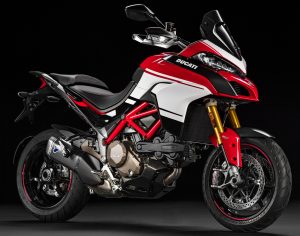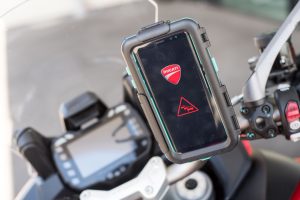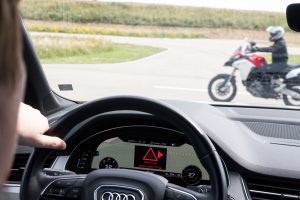Italian superbike manufacturer Ducati teamed up with automotive giants Audi AG and Ford Motor Company and Qualcomm Technologies, Inc., a subsidiary of Qualcomm Incorporated to come up with a communication system that interlinks vehicles, street infrastructure, and pedestrians. The Connected Vehicle to Everything or C-V2X project is a key part of Ducati’s “Safety Road Map 2025” strategy which aims to develop new safety systems and technologies for roadside safety, traffic efficiency and automated driving.
At the Consumer Electronic Show (CES) 2019, a Ducati Multistrada 1260 and vehicles from Audi and Ford equipped with C-V2X technology demonstrated how to safely negotiate the right-of-way in entering a four-way non-signalized intersection using wireless sensors with intention sharing and non-line-of-sight (NLOS) conditions. The demo also exhibited three safety scenarios: the Vehicle-to-Vehicle (V2V) case featuring the Intersection Movement Assist (IMA) scenario to help avoid angle collisions at intersections; the Vehicle-to-Pedestrian (V2P) case to help protect pedestrians and bicyclists; and the Vehicle-to-Infrastructure (V2I) case featuring the Work Zone Warning scenario, to help provide drivers with advanced warning of road construction ahead.
The CES 2019 demo follows the successful C-V2X interoperability trials in 2018 throughout Europe, Japan, Australia, China and the United States. Currently, C-V2X provides an evolution path to 5G and is designed to deliver reliable and consistent performance in realistic driving scenarios. It complements other Advanced Driver Assistance System (ADAS) sensors such as radar, lidar, and camera systems; supports an expanding set of safety use cases; and enhances situational awareness by detecting and directly exchanging vital information. C-V2X also benefits from established security transport layers and application protocols defined by the automotive standards communities, including ISO, ETSI and IEEE 1609. And because it can be easily integrated into all wireless modems to offer direct and network communications, C-V2X implementation is cost-effective, especially when adding wireless connectivity in all vehicles.
“Imagine a person suddenly steps into the street from out of view and your vehicle stops because it was alerted by that person’s smartphone. This is just one example of how C-V2X can connect smart vehicles to a smart world,” said Don Butler, executive director, Ford Connected Vehicle Platform and Product. “We invite other automakers, governments and tech companies to join this significant momentum to build a C-V2X ecosystem”.
 Power Wheels Magazine A Notch Above
Power Wheels Magazine A Notch Above




